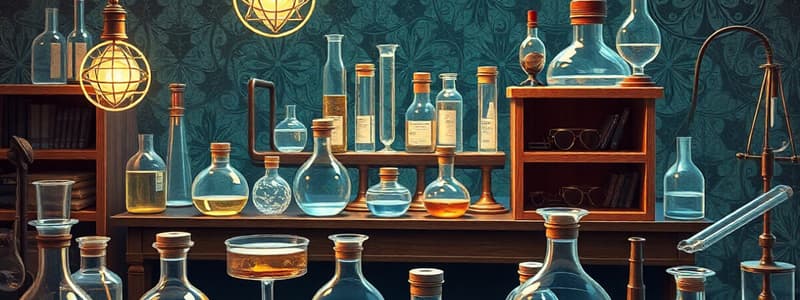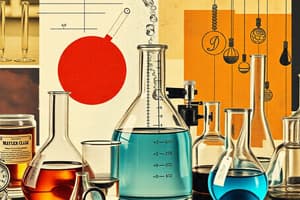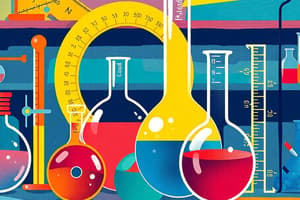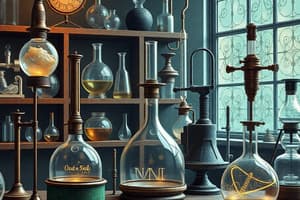Podcast
Questions and Answers
What are the main products of the light reactions in photosynthesis?
What are the main products of the light reactions in photosynthesis?
- Glucose, NADPH & ATP
- Oxygen, glucose & water
- ATP, NADPH & oxygen (correct)
- Glucose, carbon dioxide & oxygen
Which of the following statements about the Calvin Cycle is true?
Which of the following statements about the Calvin Cycle is true?
- It requires light directly to function.
- It occurs in the thylakoid membrane.
- It produces glucose from CO2, NADPH, and ATP. (correct)
- It involves the absorption of blue light only.
What occurs during the G1 phase of the cell cycle?
What occurs during the G1 phase of the cell cycle?
- Cells stop synthesizing proteins.
- Cells prepare for mitosis directly.
- DNA replication takes place.
- Normal cell functions and protein synthesis occur. (correct)
Which component is NOT part of a nucleotide?
Which component is NOT part of a nucleotide?
Which of these pigments reflects red and purple light?
Which of these pigments reflects red and purple light?
What is the final outcome of the S phase in the cell cycle?
What is the final outcome of the S phase in the cell cycle?
Which statement accurately describes RNA compared to DNA?
Which statement accurately describes RNA compared to DNA?
What role do proteins have in cells?
What role do proteins have in cells?
Which structure is primarily responsible for protein synthesis in eukaryotic cells?
Which structure is primarily responsible for protein synthesis in eukaryotic cells?
Which of the following statements is true regarding nucleotides in DNA and RNA?
Which of the following statements is true regarding nucleotides in DNA and RNA?
What is the function of the Golgi apparatus in a eukaryotic cell?
What is the function of the Golgi apparatus in a eukaryotic cell?
Which test is specifically used to identify the presence of starch?
Which test is specifically used to identify the presence of starch?
Which type of fatty acid contains at least one double bond?
Which type of fatty acid contains at least one double bond?
What is created through dehydration synthesis?
What is created through dehydration synthesis?
Which of the following is a characteristic of simple diffusion?
Which of the following is a characteristic of simple diffusion?
What form do monosaccharides take when they combine to form disaccharides?
What form do monosaccharides take when they combine to form disaccharides?
What is the main purpose of meiosis?
What is the main purpose of meiosis?
During which phase of mitosis do sister chromatids align at the equator of the cell?
During which phase of mitosis do sister chromatids align at the equator of the cell?
Which event occurs during Prophase I of meiosis?
Which event occurs during Prophase I of meiosis?
What is the role of spindle fibers during mitosis?
What is the role of spindle fibers during mitosis?
At the end of which phase do cells physically separate into two daughter cells?
At the end of which phase do cells physically separate into two daughter cells?
What characterizes haploid cells?
What characterizes haploid cells?
Which term describes the alternative versions of the same gene found on homologous chromosomes?
Which term describes the alternative versions of the same gene found on homologous chromosomes?
What happens during anaphase of mitosis?
What happens during anaphase of mitosis?
Flashcards
Chlorophyll A
Chlorophyll A
A primary pigment that absorbs light energy for photosynthesis
Photosynthesis Stage 1
Photosynthesis Stage 1
Light-dependent reactions that use light and water to produce ATP, NADPH, and oxygen.
Photosynthesis Stage 2
Photosynthesis Stage 2
Light-independent reactions (Calvin Cycle) that use CO2, ATP, and NADPH to produce glucose.
Nucleotide components
Nucleotide components
Signup and view all the flashcards
DNA role
DNA role
Signup and view all the flashcards
Cell Theory (1)
Cell Theory (1)
Signup and view all the flashcards
Cell Cycle (Interphase)
Cell Cycle (Interphase)
Signup and view all the flashcards
Cell cycle (G1 phase)
Cell cycle (G1 phase)
Signup and view all the flashcards
Organic Molecule
Organic Molecule
Signup and view all the flashcards
Monomer
Monomer
Signup and view all the flashcards
Polymer
Polymer
Signup and view all the flashcards
Carbohydrates
Carbohydrates
Signup and view all the flashcards
Simple Sugar
Simple Sugar
Signup and view all the flashcards
Unsaturated Fatty Acid
Unsaturated Fatty Acid
Signup and view all the flashcards
Benedict's Test
Benedict's Test
Signup and view all the flashcards
Passive Transport
Passive Transport
Signup and view all the flashcards
Mitosis
Mitosis
Signup and view all the flashcards
Cytokinesis
Cytokinesis
Signup and view all the flashcards
Meiosis
Meiosis
Signup and view all the flashcards
Gametes
Gametes
Signup and view all the flashcards
Homologous Chromosomes
Homologous Chromosomes
Signup and view all the flashcards
Haploid Cell
Haploid Cell
Signup and view all the flashcards
Crossing Over
Crossing Over
Signup and view all the flashcards
Independent Assortment
Independent Assortment
Signup and view all the flashcards
Study Notes
Lab Equipment
- Accuracy is how close a measured value is to the true value.
- Precision is how close measured values are to each other.
- The meniscus is the curve of a liquid at the surface, where it touches another material.
- Beaker: used for stirring, mixing and transferring solutions.
- Flask: used for reactions or mixing/heating.
- Graduated cylinder: has measurement lines, more precise than beakers for measuring small volumes.
- Pipettes: transfer fluids, can be graduated for precise measurements.
- Aspirate: to draw up a sample.
- Dispense: to deliver a sample.
- Blow-out: empty the tip completely after using a pipette.
Science and the Scientific Method
- Science is an active, dynamic, and objective process of gathering and organizing information about the natural world.
- Goal of Science: gain knowledge about the natural world.
- Modern Scientific Research: often goal-directed (applied technology).
- Hypothesis: an explanation limited in scope, based on prior knowledge.
- Theory: a powerful, broad explanation supported by extensive testing and accurate predictions about phenomena. No scientific idea is ever completely "proved"
- Science: focuses on natural explanations, not opinions, judgments, beliefs, or supernatural phenomena. It doesn't make moral judgments.
Microscopy and Cell Types
- Cell Theory: all life is composed of cells, cells are functional units of life, and all cells come from pre-existing cells.
- Scanning electron microscope (SEM): visualizes cell surfaces, requiring a thin metal coating; produces high-resolution, 3-D images.
- Transmission electron microscope (TEM): visualizes internal cell structures; produces high-resolution, 2-D images.
- 3-part Cell Theory: All life is composed of cells, cells are the functional units of life, and all cells come from pre-existing cells
Organic Molecules
- Organic molecules contain carbon, often with hydrogen. Some examples include: methane, carbohydrates, proteins, fats, and nucleic acids (DNA/RNA).
- Monomers: single units of carbohydrates, proteins, and nucleic acids.
- Polymers: formed from joining monomers.
- Carbohydrates include simple sugars and polysaccharides.
- Monosaccharides: simple sugars; building blocks of carbohydrates.
Membrane Transport
- Passive transport: no energy required across a membrane; includes simple diffusion, osmosis.
- Diffusion: movement of particles from areas of high concentration to low concentration.
- Osmosis: diffusion of water across a semi-permeable membrane.
- Aquaporins: special water channels in cell membranes.
- Active transport: requires energy to move substances across a membrane against the concentration gradient. includes exocytosis and endocytosis.
Cellular Respiration
- Cellular respiration: organisms extract & put potential energy from glucose, into ATP.
- Glycolysis: glucose is split in half, some energy transferred to electrons.
- Krebs Cycle: The Krebs cycle is where pyruvate's derivative is oxidized; and some energy is transferred to electrons
- Electron Transport Chain: electrons' energy forms ATP. Oxygen is the final acceptor of electrons.
Photosynthesis
- Photosynthesis: autotrophs capture light energy and use it to produce glucose.
- Chlorophyll: pigment that absorbs light energy for photosynthesis.
- Auxiliary pigments: (carotenoids, anthocyanins) absorb light in different ranges.
- Photosystems: large protein structures in the thylakoid membrane that harvest light energy.
- Stages: light reactions and Calvin cycle.
DNA, Cell Cycle, and Mitosis
- DNA stores instructions. A cell cycle progresses from start to finish of one cell division, to the next. Key phases are mitosis and interphase.
- Cell theory: All cells come from pre-existing cells.
- Main components of a nucleotide: five carbon sugar, phosphate group, and a nitrogenous base.
- Different types of Nitrogenous bases: Purines (adenine/guanine), pyrimidines (thymine/cytosine); and Uracil, a pyrimidine, is used in RNA.
- RNA: contains uracil (U) instead of thymine for its nitrogenous base composition.
Cell Division (Meiosis/Mitosis)
- Meiosis: cell division to form gametes (sex cells); reduces the chromosome number to half.
- Mitosis: cell division (somatic cell division) that results in two identical daughter cells; for growth & repair.
- Gametes: haploid sex cells (egg and sperm).
- Zygote: fertilized egg (diploid); first cell of new organism.
- Homologous chromosomes: matched pairs of chromosomes with similar gene order and location.
Genetics and Inheritance
- Homozygous: having two identical alleles for a gene.
- Heterozygous: having two different alleles for a gene.
- Dominant allele: expressed in the heterozygote.
- Recessive allele: masked in heterozygote.
- Complete Dominance: one allele is fully dominant over another.
- Mendelian Ratio: the phenotypic ratio of 3:1 observed in the offspring generation of a monohybrid cross.
- Principle of Segregation: each allele for a trait separates during gamete formation.
- Principle of Independent Assortment: alleles for one trait separate independently of alleles for other traits during gamete formation.
- Phenotype is a visible trait (actual appearance).
- Genotype is a set of alleles that form the gene (the genetic code).
- Karyotyping: used to study chromosomal abnormalities and arrange based on size.
Studying That Suits You
Use AI to generate personalized quizzes and flashcards to suit your learning preferences.
Related Documents
Description
Test your knowledge of lab equipment and the scientific method! This quiz covers important concepts such as accuracy, precision, and various types of lab tools like beakers and pipettes. Additionally, it explores the foundational aspects of scientific inquiry and research methodology.




